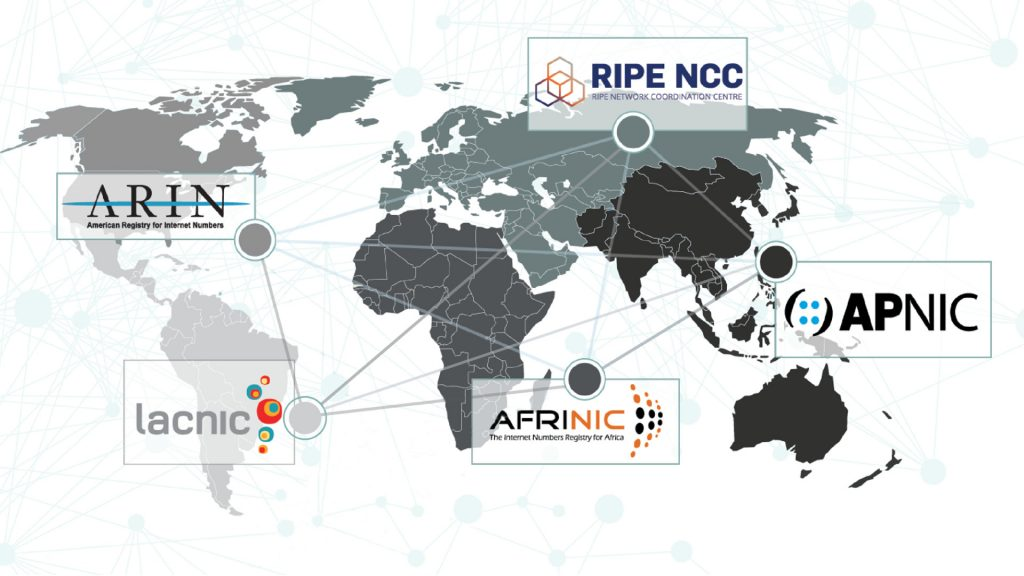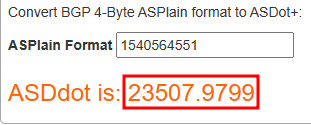Overview:
Author: Diyaa
Published date: August 4th, 2024
Last updated: August 10th, 2024
Warning
You are reading an incomplete article.
This document will outline the theory behind how BGP operates. I plan on having all of my BGP notes in single document for ease of access/use.
About Me:
My name is Diyaa. I graduated from a network engineering post secondary program in 2023. I like to spend majority of my personal time making network infrastructure diagrams and technical documentation like the article you are reading right now. I am able to make large scale networks at home thanks to Proxmox virtual environment.
Link to original
Routing Theory:
Interior Gateway Routing Protocols:
Interior Gateway Routing Protocols (IGP):
Interior Gateway Protocols (IGP) are routing protocols that run within a single autonomous system. They manage all the networks within a single organization’s routing domain.
Example
Here are some examples of IGP routing protocols:
- iBGP.
- RIPv1.
- RIPv2.
- EIGRP.
- OSPFv2.
- OSPFv3.
- IS-IS.
The most famous IGP routing protocol in North America is OSPF. However, IS-IS may be more famous in other parts of the world.
Link to original
Exterior Gateway Routing Protocols:
Exterior Gateway Routing Protocols (EGP):
Exterior Gateway Protocols (EGP) are routing protocols that run in between different autonomous systems. They allow the sharing of routing information across different autonomous systems.
Link to originalExample
Here are some examples of EGP routing protocols:
- eBGP.
Administrative Distance:
eBGP has an administrative distance of 20 and iBGP has an administrative distance of 200.
Administrative Distance (AD):
The administrative distance is the trust worthiness of a routing protocol. The lower the administrative distance, the more trustworthy the routing protocol.
Note
This table below presents the default administrative distance values for Cisco IOS. Other vendors might choose to implement AD with different values.
Link to original
Routing source Administrative distance Comments Directly connected (IP on the interface) 0 Static route 1 eBGP 20 EIGRP (Internal) 90 IGRP 100 Rare to see IGRP these days. OSPF 110 IS-IS 115 EGP (Exterior Gateway Protocol) 140 You might be over 50 years old if you have seen this in your life span. RIP 120 EIGRP (External) 170 iBGP 200 DHCP learned routes 254 Unknown/Untrusted 255
IP Addresses and public ASNs Allocation:
Public IPs and BGP ASNs allocation:
Reference for this section:
footnote
packetpushers-01under the References section at the bottom of the page 1.Public IP address are network ranges that are routable over the public internet. IPv4 or IPv6 packets with these addresses in the source and/or destination will not be filtered (dropped) by Internet Service Providers (ISPs.)
Internet Assigned Numbers Authority (IANA) is responsible for the coordination of the internet standards and number assignments. IANA is responsible for the following tasks:
- Global pool of IPv4/IPv6 addresses and block allocations for each region (network layer addresses).
- Protocol number assignment (protocol identification numbers).
- Port numbers assignment (transport layer addresses).
- DNS root zones.
The screenshot below shows the Regional Internet Registry (RIR) organizations that are responsible for the allocation of public IPv4, IPv6 addresses, as well as public BGP Autonomous System Numbers (ASNs) within their perspective region.
Link to original
- American Registry for Internet Numbers (ARIN).
- Reseaux IP Européens Network Coordination Centre (RIPE NCC).
- Asia-Pacific Network Information Centre (APNIC).
- Latin American and Caribbean Network Information Centre (LACNIC).
- African Network Information Centre (AFRINIC).
BGP Routing Theory:
Note
A large portion of my notes are from Kevin Wallace training videos 1.
Introduction To BGP:
Boarder Gateway Protocol (BGP) is known as an Exterior Gateway Protocol (EGP) that is capable of sharing routes in between autonomous systems. There are BGP autonomous system numbers available (Not all the ASNs are available for public use).
BGP is capable of doing interior and exterior routing as well. The famous BGP that runs the internet is the External Boarder Gateway Protocol (eBGP). There is another type of BGP that runs as an Interior Gateway Protocol (IGP), it is the Internal Boarder Gateway Protocol (iBGP).
Difference Between eBGP and iBGP:
The External Boarder Gateway Protocol (eBGP) runs across different Autonomous System (AS), while Internal Boarder Gateway Protocol (iBGP) runs between Autonomous Systems (AS).
iBGP routers assume that all the other routers within the autonomous system have the routes of the AS. However, there is a BGP Route Reflector configuration option to force iBGP to share routers to neighboring routers. eBGP will naturally share routes to neighboring routers since they are in an external autonomous system.
BGP Features and Advantages:
BGP has the following features and advantages:
- Path-vector routing protocol:
- Reliable updates - However, this makes it slow.
- Triggered updates only - BGP won’t be sending updates periodically.
- Uses attributes to determine the best path.
- inter-domain routing protocol.
- External BGP is used between service providers as a transit in between autonomous system.
- Multihomed: A client can have multiple ISPs and advertise the same subnet.
- Large enterprise scale network routing protocol.
- Very scalable: Can handle massive amount of routes.
- Not the fastest routing protocol. It was meant to be scalable.
- Non-trusting protocol: You don’t trust the service provider, the service provider doesn’t trust you. The trust here is more in terms of implementation.
- Policy-based.
- Multi-protocol support: Some examples of that can be - IPv6, IPv4, VXLAN, etc…
- Uses Autonomous System (AS) numbers.
BGP Characteristics:
Important
NLRI is usually referred to as a Route Advertisement (RA). In BGP NLRI has similar characteristics of the OSPF route advertisements. However, it is not the same thing.
These are some of the characteristics of BGP:
- Neighbor’s IP address must be set explicitly in the configuration of the router.
- Establishes TCP sessions on port 179.
- Advertises address prefix and length. This is known as Network Layer Reachability Information (NLRI).
- Advertises a collection of path attributes used for path selection. It has 11 path attributes.
- It is called a path vector routing protocol, because it records the entire path to the destination.
BGP Autonomous System Numbers:
Tip
The private ASN numbers are reserved for internal use just like the RFC1918 ranges in IPv4.
The ASN field was updated to 32 bits after the exhaustion of public AS numbers when it was 16 bits long.
This is a table of all the ASN ranges and their assignments by IANA.
| Number | Bits | Description | Reference |
|---|---|---|---|
| 0 | 16 | Reserved for RPKI unallocated space invalidation | RFC 6483, RFC 7607 |
| 1–23455 | 16 | Public ASNs | |
| 23456 | 16 | Reserved for AS Pool Transition | RFC 6793 |
| 23457–64495 | 16 | Public ASNs | |
| 64496–64511 | 16 | Reserved for use in documentation and sample code | RFC 5398 |
| 64512–65534 | 16 | Reserved for private use | RFC 1930, RFC 6996 |
| 65535 | 16 | Reserved | RFC 7300 |
| 65536–65551 | 32 | Reserved for use in documentation and sample code | RFC 5398, RFC 6793 |
| 65552–131071 | 32 | Reserved | |
| 131072–4199999999 | 32 | Public 32-bit ASNs | |
| 4200000000–4294967294 | 32 | Reserved for private use | RFC 6996 |
| 4294967295 | 32 | Reserved | RFC 7300 |
Reference for the table above 2.
Autonomous System Number 2-bytes format:
The 2-bytes ASN has () possible AS numbers. IANA reserves 1026 of these numbers (64512-65534) for private ASN use. You can look at the table under BGP Autonomous System Numbers for more information about the allocation of the ASNs.
ASNs in between 0 and 65535 are called mappable ASNs, because they can be presented in 2-bytes.
References for this section 3 4.
Autonomous System Number 4-bytes format:
The 4-bytes ASN has () possible AS numbers. IANA reserves the range of 4,200,000,000–4,294,967,294 for private ASN use. You can look at the table under BGP Autonomous Systems for more information about the allocation of the ASNs.
References for this section 3 4.
Autonomous System plain (asplain) decimal presentation of the ASN:
This is the simplest way of representing an ASN. You simply type the number in decimal format. The range is in between 0 and 4,294,967,295.
Autonomous System dot plus (asdot+) presentation of the ASN:
This form of representation breaks the ASN into two 16-bit sections with a dot in the middle.
The presentation of asdot+ contains the following values:
- low-order value: First 16 bits
- high-order value: Last 16 bits
Example
6.65535low-order value: 6 high-order value: 65535
Converting values below 65536:
To convert an asplain value below 65536 to asdot+, you simply write the value in the high-order field with the low-order field being set to 0.
Example
- Asplain: 65535
- Asdot+: 0.65535
Converting values over 65535:
Bug
- This calculation doesn’t apply for AS number 65536. The reason is that computers believe in 0 and see it as a number, but humans do not believe in 0 as a number.
- 65536 in asplain is presented as 1.0 in asdot+.
Low-order value calculation:
Caution
Do not round the value up or down. Just use the whole number and ignore everything else.
high-order value calculation:
Representation of asdot+:
You now simply place the numbers on the correct side of the dot.
low-order.high-order
Example
Convert 1,540,564,551 from asplain representation to asdot+ representation.
You can validate the answer on the following website: asplain to asdot+ BGP converter
Autonomous System dot (asdot) presentation of the ASN:
Asdot is combines the presentation of asplain and asdot+. The ASNs that fit in the first 16-bit low-order value are written in asplain (Autonomous System plain (asplain) decimal presentation of the ASN) (0 to 65535). Anything over 65535 is written in asdot+ (Autonomous System dot plus (asdot+) presentation of the ASN).
BGP Route Reflector:
In iBGP there is an issue that requires the route reflector. By default iBGP assumes that if a neighbor advertises a route, that it advertised it to everyone else within the autonomous system. This is because iBGP assumes full internal mesh topology in between all the routers. The issue with full mesh connectivity is that it requires a large number of neighborships to form when scaling.
The route reflector tells an iBGP router to advertise a route it learned to all of it's neighbors without a full mesh connectivity.
The screenshot below shows how BGP assumes the network is configured without the route reflector configuration.
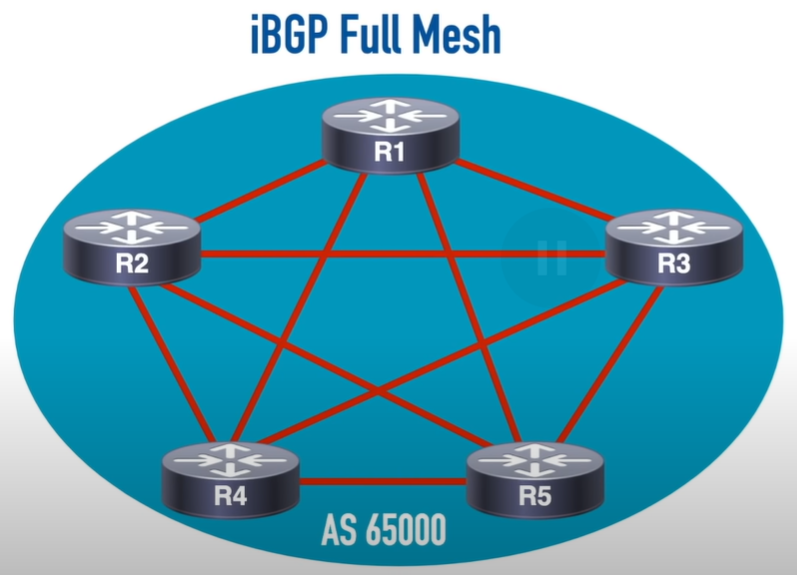
The screenshot below shows how BGP would function with the route reflector configuration.
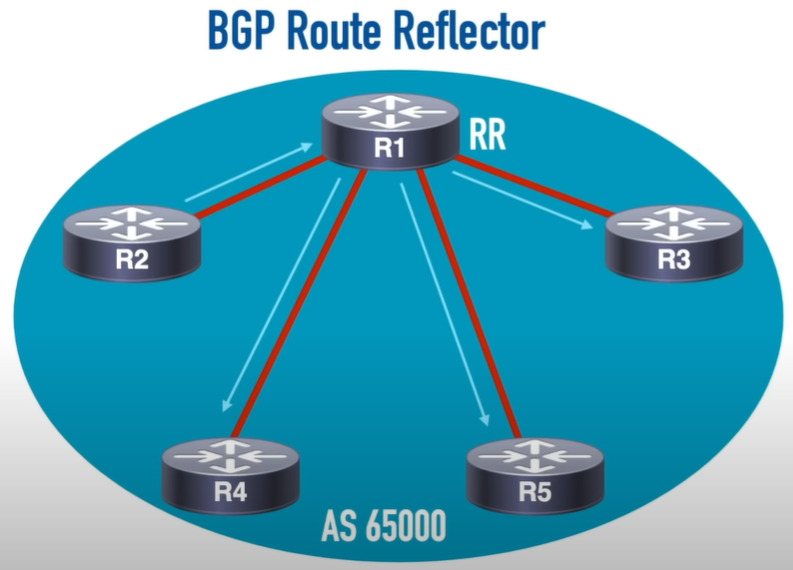
Tip
If you are familiar with the role of the Designated Router (DR) in OSPF, you can look at the route reflector in BGP the same way. Assume that R4, R5, and R3 are DROTHERs.
Reference for screenshots in this section 1.
BGP Confederation:
BGP confederation allows the use of sub-autonomous systems. A full mesh connectivity is required within a sub-autonomous system, but not in between the sub-autonomous systems.

Reference for screenshots in this section 1.
Neighborship Formation:
The neighborship formation in BGP starts with the TCP 3-way handshake.
BGP states:
Important
The port that BGP uses is TCP/179.
- Idle: sent the SYN packet of the TCP handshake.
- Connect: received the SYN/ACK packet of the TCP handshake.
- Active: sent the ACK packet and completed the 3-way TCP handshake.
- Open Sent: BGP Open relationship message.
- Open Confirm: BGP confirms the relationship.
- Established: BGP neighborship has been formed and routes can be exchanged now.
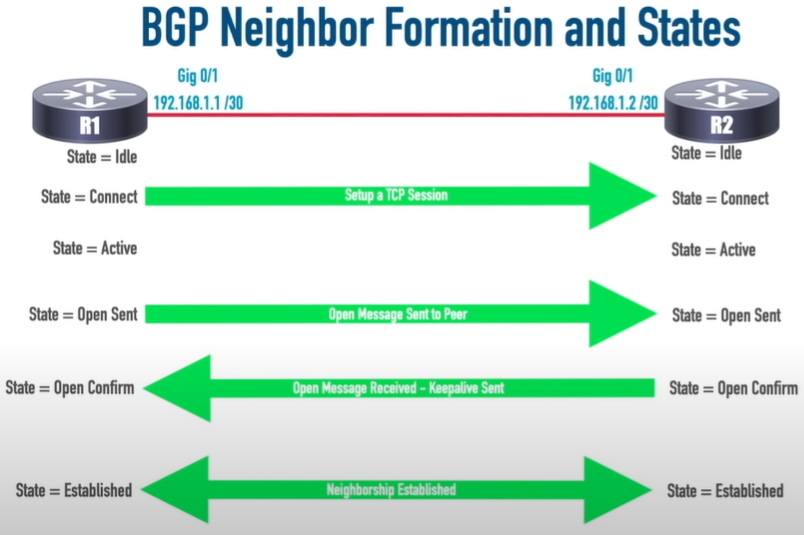
Reference for screenshots in this section 1.
BGP Open Message:
Default BGP timers:
Keepalive: 60 seconds. Hold-time: 180 seconds.
The BGP open message contains the following information:
- BGP version number (This will be version 4 most of the time).
- Local autonomous system number.
- Hold time.
- BGP router ID.
- Optional parameters.
BGP Keepalive Message:
Important
If BGP doesn’t hear from a neighbor after the keepalive timer expires. It will wait until the hold-time timer expires before revoking the neighborship.
This message is sent to keep the hold-time timer from expiring.
BGP Update Message:
The BGP update message may contain the following information (depending on the update):
- withdrawn routes.
- Path attributes.
- Network Layer Reachability Information (NLRI).
BGP Notification Message:
The BGP notification message may contain the following information:
- An error code.
- An error subcode.
- Information about the error.
BGP Path Selection:
Important
The 8 path selection attributes I have in this section aren’t the only path selections attributes for BGP out there. However, the majority of these path selection attributes are the most common across multiple vendor’s implementation of BGP.
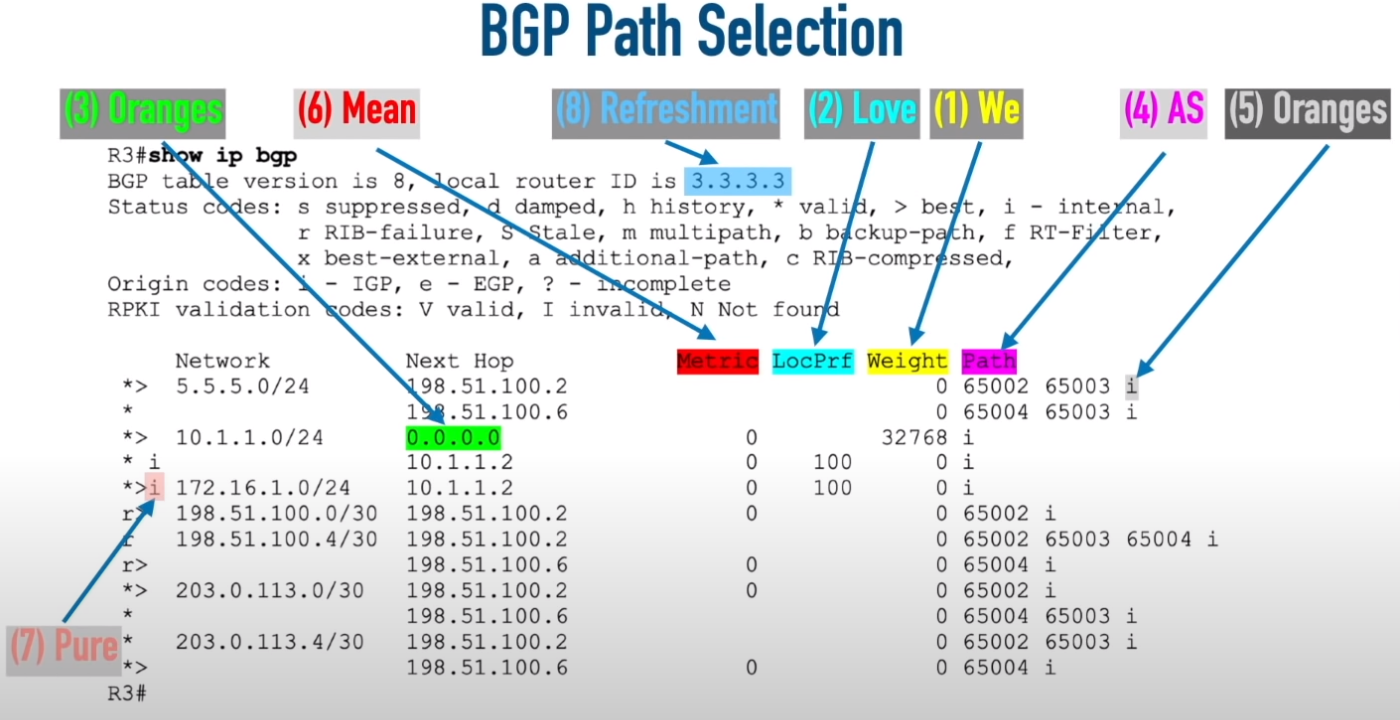
Reference for screenshots in this section 1.
One of the phrase that could be used to remember the path selection attributes is: We Love Oranges As Oranges Mean Pure Refreshment. This passphrase is used by Kevin Wallace in his training videos.
Warning
Do not mistake the path selection attribute (prefers the lowest router ID) with the router ID election process.
| Order of matching | Path selection attribute | Description | Influence | |
|---|---|---|---|---|
| 1 | Weight | Locally significant, Cisco-specific parameter. Commonly used to influence outbound routing decisions. Can be used to prioritize one link over the other. | A higher value is preferred | |
| 2 | Local Preference | Communicated through a single AS to influence outbound routing decisions. | A higher value is preferred | |
| 3 | Originate | Paths sourced locally are preferred. | Directly connected links are preferred | |
| 4 | AS path length | The number of autonomous systems in the “AS_PATH” attribute. Lower AS path lengths are preferred. Commonly used to influence inbound routing decisions. | Lower value is preferred | |
| 5 | Origin type | Indicates how the route was injected into BGP. i (network command), e (EGP), or ? (redistributed). | (i) is preferred to (e), and (e) is preferred to (?) | |
| 6 | Multi-Exit Discriminator (MED) | set and advertised by routers in one AS to influence the BGP path selection decision of routers in another AS. This might be known as Metric in some vendor’s implementation of BGP | A lower MED is preferred | |
| 7 | Paths | Prefer eBGP path over iBGP path. | eBGP has an AD of 20. However iBGP has an AD of 200 | |
| 8 | Router ID | A tie breaker. The route received from the router with the lowest router ID. | Lowest router ID is preferred |
BGP Synchronization:
BGP synchronization is a rule that avoids an unintentional network (aka, black hole). This feature tells the router to only advertise a route learned from an iBGP peer to an eBGP peer when there is an exact match of that route learned from an IGP in the routing table.
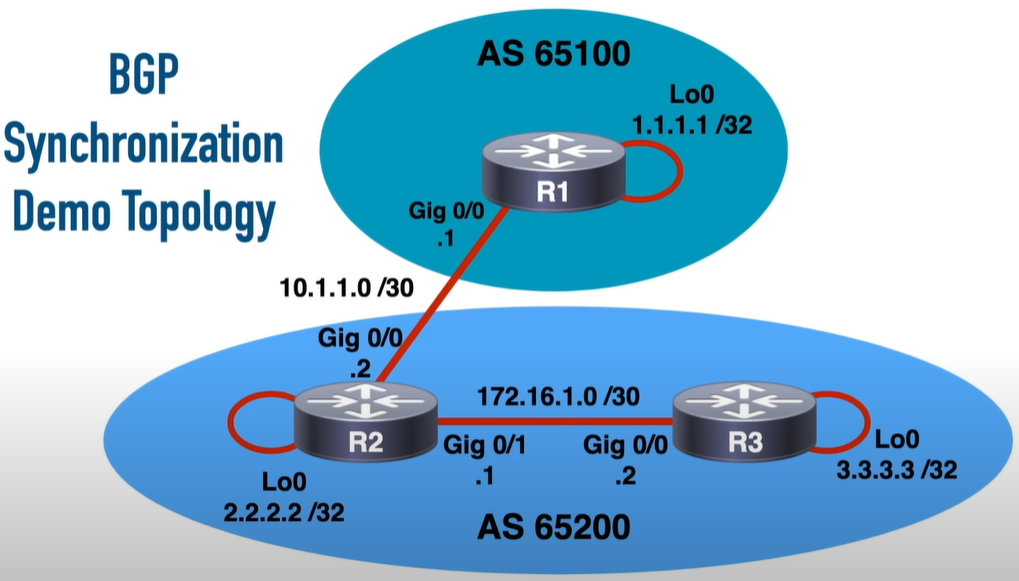
Reference for screenshots in this section 1.
Warning
BGP Synchronization might be turned off on most vendor equipment by default. This feature can cause issues.
An example of BGP synchronization is shown in the screenshot above. In this case, R2 will not advertise 3.3.3.3/32 to router R1 through eBGP if synchronization is turned on and that network isn’t advertise to R2 from R3 through an Interior Gateway Protocol (IGP). This guarantees that R2 won’t advertise a network that it doesn’t know.
BGP Summarization:
Personal opinion:
If the routes you are trying to summarize aren't contagious, that might cause routing loops. I have done that in my home lab multiple times. You might ask.. What is an example of a contagious set of networks?
- 172.16.0.0/24
- 172.16.1.0/24
- 172.16.2.0/24
- 172.16.3.0/24
The networks listed above are contagious and can be summarized as a single 172.16.0.0/22 summary route.
You might also ask.. What is an example of a non-contagious set of networks?
- 172.16.0.0/24
- 172.16.2.0/24
- 172.16.3.0/24
In the above example, the network of 172.16.1.0/24 is missing. Therefore, this is a non-contagious set of networks. Advertising these networks as a 172.16.0.0/22 summary might result in routing loops for traffic to the 172.16.1.0/24 network.
Route summarization is the idea of turning multiple contagious routes into a single route. This helps improve the efficiency of the routers by reducing the size of the routing table. Some vendor’s implementation of BGP might refer to route summarization as route aggregation.
eBGP Multihop:
The multihop feature in BGP allows for a router to establish BGP neighborship with a non-adjacent router. That means, the routers don’t share the same broadcast domain at layer 2. This is only needed/available in eBGP and not in iBGP.
BGP Path Hunting/Exploration:
In BGP, the routers can’t afford to have a flapping link. A flapping link will result in route dampening. If there is a flapping interface on a router that has formed a BGP neighborship with another router, that router might get their routes dampened. BGP dampens the path to the AS. This BGP feature is known as BGP Route Flap Dampening (RFD).

BGP is fully converged in the first state of the network in the diagram above. The moment a link connected to a peer becomes unavailable. The following steps are taken:
- BGP sends withdrawn messages to its neighbors.
- The upstream BGP routers in the neighboring autonomous system will run the path selection algorithm again to determine what is the best path.
- The route to the network is placed in the routing table and BGP will send an announcement message of the updated path to it’s neighbors.
The issues with route dampening is that there may be multiple paths to an autonomous system with a downed link. This could lead to BGP taking minutes to hours before it reconverges again.
There are multiple factors that affect the speed at which a route is dampened:
- Processing.
- Queuing.
- Propagation delays.
- Minimum Route Advertisement Interval (MRAI).
- Violation policy penalties applied by neighbors based on specified thresholds.
A flapping interface/routes on a BGP peer might result in that peer having its routes dampened from BGP. Some ISPs might implement penalties and suppression threshold timers. That can reduce the number of announcements and withdrawn messages the “ISP” peer has to send to it’s upstream neighbors. However, the issue is when an AS has redundant links to multiple service providers. That can result in BGP taking hours to stabilize the path selection process for the flapping route(s).
Reference for this section 5.
Aggressive BGP route flap dampening:
Some service providers might choose to implement aggressive route flap dampening policies. This might include thresholds of timers based on the length of the prefix being advertised. A /24 network might get a higher suppression timer than a /19 network. This approach maybe required when the ISP is doing prefix aggregation (summarization) into BGP to improve the efficiency and reduce the number of routes on the “internet”.
Reference for this section 5.
Technical Configuration:
Note
All the configuration syntax I will be using in my documentation is referencing the Cisco IOS syntax. However, a large portion of the commands and what they do might be similar to other vendors syntax.
Tip
In the real world. An organization with an AS assigned to them by their RIR provider CAN NOT advertise to BGP unless they have a minimum prefix size of
/24. This is to reduce the size of the internet routing table and increase routing efficiency.
Basic BGP Configuration:
Reference for screenshots in this section 1.
R1 configuration:
R1# configuration terminal
R1(config)# router bgp 64500
R1(config-router)# neighbor 198.51.100.2 remote-as 64495
R1(config-router)# network 192.0.2.0 mask 255.255.255.0R2 configuration:
R2# config term
R2(config)# router bgp 64495
R2(config-router)# neighbor 198.51.100.1 remote-as 64500
R2(config-router)# network 203.0.113.0 mask 255.255.255.0Commands for validating BGP is working:
- Show the routing table:
Rx# show ip route- Show the BGP table:
Rx# show ip bgpAdvanced BGP Configuration:
To be continued…
Pick up here
Related Notes:
- Link to Home-Page.
